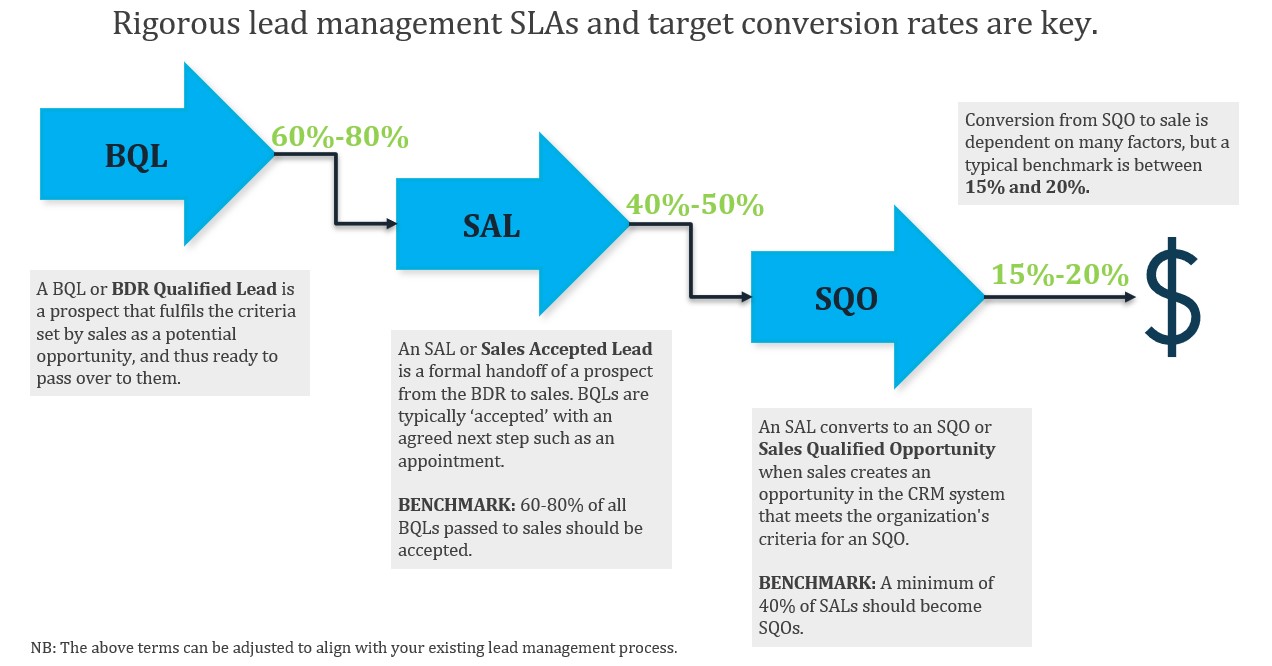Is the SAL the only KPI that really matters?
The holy grail of conversion rates is the one from marketing to sales, from MQL to SAL, simply because it’s the key to unlocking revenue and growth.
Enrico Brosio, President, MarketOne International
So many KPIs, so little time
The world of B2B demand generation has more than its fair share of key performance indicators, or KPIs. There’s CPC (cost per conversion), CPL (cost per lead), MQL (marketing qualified lead), TGL (tele generated lead), TQL (tele prospecting qualified lead); we won’t go on. While together they provide a clear picture of how a business is performing, help to identify areas for improvement, and guide decision-making, not all KPIs are created equal.
Revenue is important but as a KPI, it’s a blunt instrument. If you focus on sales revenue, all you know is that sales are selling or not selling well. What’s more valuable is understanding how leads generated by marketing are nurtured into prospects who are willing to buy. Deep diving into the conversion rate where marketing and sales meet, from MQL (marketing qualified lead) to SAL (sales accepted lead), reveals the channels, content and campaigns that are performing most effectively and converting into SALs at a higher rate. This helps to optimize resources, tailor and personalize messaging to better fit the target audience and create better alignment between sales and marketing, driving revenue it its wake.
What’s so special about the SAL anyway?
Let’s take a closer look at the sales accepted lead, which is a lead that has been qualified by the BDR (business development representative) before it has been accepted by the sales representative. It has a high chance of converting into a customer and has met some lead qualification criteria such as need, previously expressed interest in your offering, level of authority to make buying decisions, budget, timeline for purchasing and fit for ICP (ideal customer profile).
Once qualified as a SAL, the lead is ready to move down your sales funnel where it will continue to be developed by sales until possible further qualification as a SQL (sales qualified lead), until (hopefully) the lead turns into a customer. While marketing can generate a high volume of leads, it is the conversion of those leads into SALs that ultimately determines the success of a campaign or strategy.
Importantly, sales accepted leads are only as good as their ability to convert to the next stage in the funnel, usually when an opportunity gets created in the CRM as a sales qualified lead (SQL) or a sales qualified opportunity (SQO). To avoid SALs being accepted by sales that don’t progress, there should be an agreed definition of the SAL quality in the SLA between marketing and sales. At MarketOne, we start with the BDR qualified lead or BQL. Rigorous qualification at this point should ensure that 60-80% of BQLs are accepted by sales and become SALs, and we then typically aim for a 50% conversion rate from sales-accepted leads to opportunities. From there, it is expected that around 20% to 30% of opportunities will convert into successful business deals. If the conversion rate from sales-accepted leads to opportunities falls below 50%, we reevaluate the SLA between marketing and sales to determine what qualifies as a valid sales-accepted lead.

The challenges in delivering better SALs
How do marketing teams get better at delivering leads that are a good fit for a SAL? A common complaint by sales is that MQLs are mostly low quality, or there simply aren’t enough leads coming to them to work with. Most of this issue stems from using low cost per lead (CPL) ‘one and done’ campaigns, such as content syndication or ad campaigns, that work to generate a large quantity of leads and keep the pipeline full.
Delivering lots of leads on a limited budget means more sales, right? Not necessarily. For starters, CPL campaigns don’t indicate the quality of leads – qualification criteria are minimal, and there may only be a handful that are a good fit for your business, have the right budget and intent to spend.
Stats show that cost per lead for Google Ads has significantly increased with 21 out of 23 industries seeing an increase in CPL year over year, with an average overall increase of 19%. Conversion rates have decreased with an average overall of 14%. [Wordstream, Google Ad Benchmarks report, 2022]
Silos between sales and marketing exacerbate the problem – marketing qualified leads are not matched to sales criteria and marketing KPIs only serve to drive leads that are not useful for sales. Not only does this cause dissatisfaction for sales, but the cost of an SAL also increases, along with the conversion rate from MQL.
Finding a solution
When looking at the leads generated by a CPL campaign, the solution is not to directly hand leads over to sales, but to nurture and qualify them further to ensure there’s an active purchase initiative or willingness to speak to sales. Only then should sales use their skills in closing the deal and step in with emails, calls and follow-ups. But how to achieve this when the marketer’s focus is traditionally on top-of-funnel single campaign lead generation?
Enter an always-on campaign that nurtures and develops leads for longer and maximizes the possibility of conversion in every lead. This campaign engine keeps your business top of mind with prospects by way of personalized content. It builds in an active response to information requests and schedules callbacks at a future date.
All the leads that didn’t convert during the one-off campaign are not lost but fed back into mulitchannel nurture sequences to keep them warm until they’re ready. Contrast this with leads from a one-off campaign that are dumped and never touched again. With this new approach, the sales intelligence and account intelligence that you’ve developed is retained.
Surrounding the buyer with the SD360™ platform
MarketOne has developed a bespoke solution called SD360™ that uses account-based sales development to target and convert your prospects. Using sequenced sales and marketing, digital and human touchpoints, the prospect is nurtured continually until sales-ready.
Crucially, any leads unused or untouched by a single campaign are entered into an email nurturing program and (hosted either directly on the SD360TM platform or on your Marketing Automation Platform) to keep them warm until they show buyer intent. Valuable sales intelligence, account intelligence and insights are no longer discarded when a conversion fails to happen in, say, Q1 but retained and fed back into Q2 and each subsequent quarter with the result of driving incremental conversions.
What is SD360™?
SD360™ is an always-on sales development and ABM engine that inputs account lists and outputs sales-ready leads (SALs), maximizing conversions into sales. We do this by unifying siloed sales and marketing touchpoints, both digital and human, providing the B2B buyer with a unified 360° experience. Emails, social selling, microsites, landing pages, calling and sales sequences are brought together holistically to break down internal silos, drive higher conversions and create a measurable impact on revenue for your business and channel partner programs.
Optimizing your mid-funnel
In a typical buying journey, bridging the gap between top of the funnel, a visit to your website, for example, and bottom of funnel where conversion happens, is often tricky for the marketer. Potential buyers have already identified a problem they’re looking to solve and your B2B offering as a potential solution. How do you nudge these prospects to the finish line of hitting ‘buy now’?
MarketOne specializes in mid-funnel marketing (MOFU), looking up the funnel to marketing and down the funnel to sales. Mid-funnel is where you find your ideal KPI. By focusing on the SAL and cost per SAL, you can optimize both top- and bottom-of-funnel. The SD360™ managed service uses strategy and tactics to qualify CPL-generated leads further before they reach sales, maximizing their potential to convert. We call these leads BDR Qualified leads, or BQLs.
How is this achieved? With pain-pointed tactics and personalization. Using the SD360™ platform, paid social, media and ads, email sequencing, combined with landing pages and microsites provide the content and solutions to move prospects further down the funnel, while one-to-one tailored emailing, calling and social outreach address specific concerns and keep your business top of mind. SD360™ takes MQLs and CPLs and uses account-based sales development to turn them into something much more valuable to your business: sales accepted leads.
Why SD360™?
SD360™ is a mid-funnel sales development engine, targeting prospects and accounts, helping them to learn more about your brand, supporting their research, and crucially helping to turn unqualified leads generated by CPL campaigns into valuable sales accepted leads by nurturing and developing them to the point of being ready for a sales conversation.
There are other benefits to using SD360™ too:
- Iron out sales inefficiencies with a single clear dashboard of tasks
- Track and report engagement through one centralized dashboard with all data from the martech stack connected into a single resource
- Improve sales and marketing alignment as both teams get behind a single approach
- Ensure a robust lead management process by delivering highly qualified leads ready for sales engagement
Ultimately, however, it is an engine for driving SALs, and, if you focus on doing this and maintaining the quality of the leads delivered, you will unlock both growth and revenue.


